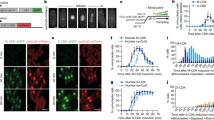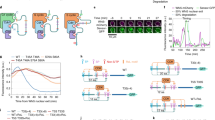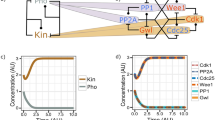Abstract
Cell-cycle events are controlled by cyclin-dependent kinases (CDKs), whose periodic activation is driven by cyclins. Different cyclins promote distinct cell-cycle events, but the molecular basis for these differences remains unclear1,2. Here we compare the specificity of two budding yeast cyclins, the S-phase cyclin Clb5 and the M-phase cyclin Clb2, in the phosphorylation of 150 Cdk1 (Cdc28) substrates. About 24% of these proteins were phosphorylated more efficiently by Clb5–Cdk1 than Clb2–Cdk1. The Clb5-specific targets include several proteins (Sld2, Cdc6, Orc6, Mcm3 and Cdh1) involved in early S-phase events. Clb5 specificity depended on an interaction between a hydrophobic patch in Clb5 and a short sequence in the substrate (the RXL or Cy motif). Phosphorylation of Clb5-specific targets during S phase was reduced by replacing Clb5 with Clb2 or by mutating the substrate RXL motif, confirming the importance of Clb5 specificity in vivo. Although we did not identify any highly Clb2-specific substrates, we found that Clb2–Cdk1 possessed higher intrinsic kinase activity than Clb5–Cdk1, enabling efficient phosphorylation of a broad range of mitotic Cdk1 targets. Thus, Clb5 and Clb2 use distinct mechanisms to enhance the phosphorylation of S-phase and M-phase substrates.
This is a preview of subscription content, access via your institution
Access options
Subscribe to this journal
Receive 51 print issues and online access
$199.00 per year
only $3.90 per issue
Buy this article
- Purchase on Springer Link
- Instant access to full article PDF
Prices may be subject to local taxes which are calculated during checkout



Similar content being viewed by others
References
Miller, M. E. & Cross, F. R. Cyclin specificity: how many wheels do you need on a unicycle? J. Cell Sci. 114, 1811–1820 (2001)
Roberts, J. M. Evolving ideas about cyclins. Cell 98, 129–132 (1999)
Stern, B. & Nurse, P. A quantitative model for the cdc2 control of S phase and mitosis in fission yeast. Trends Genet. 12, 345–350 (1996)
Fisher, D. L. & Nurse, P. A single fission yeast mitotic cyclin B p34cdc2 kinase promotes both S-phase and mitosis in the absence of G1 cyclins. EMBO J. 15, 850–860 (1996)
Moore, J. D., Kirk, J. A. & Hunt, T. Unmasking the S-phase-promoting potential of cyclin B1. Science 300, 987–990 (2003)
Cross, F. R., Yuste-Rojas, M., Gray, S. & Jacobson, M. D. Specialization and targeting of B-type cyclins. Mol. Cell 4, 11–19 (1999)
Donaldson, A. D. The yeast mitotic cyclin Clb2 cannot substitute for S phase cyclins in replication origin firing. EMBO Rep. 1, 507–512 (2000)
Peeper, D. S. et al. A- and B-type cyclins differentially modulate substrate specificity of cyclin-cdk complexes. EMBO J. 12, 1947–1954 (1993)
Ubersax, J. A. et al. Targets of the cyclin-dependent kinase Cdk1. Nature 425, 859–864 (2003)
Brown, N. R., Noble, M. E., Endicott, J. A. & Johnson, L. N. The structural basis for specificity of substrate and recruitment peptides for cyclin-dependent kinases. Nature Cell Biol. 1, 438–443 (1999)
Adams, P. D. et al. Identification of a cyclin-cdk2 recognition motif present in substrates and p21-like cyclin-dependent kinase inhibitors. Mol. Cell. Biol. 16, 6623–6633 (1996)
Schulman, B. A., Lindstrom, D. L. & Harlow, E. Substrate recruitment to cyclin-dependent kinase 2 by a multipurpose docking site on cyclin A. Proc. Natl Acad. Sci. USA 96, 10453–10458 (1998)
Takeda, D. Y., Wohlschlegel, J. A. & Dutta, A. A bipartite substrate recognition motif for cyclin-dependent kinases. J. Biol. Chem. 276, 1993–1997 (2001)
Wilmes, G. M. et al. Interaction of the S-phase cyclin Clb5 with an ‘RXL’ docking sequence in the initiator protein Orc6 provides an origin-localized replication control switch. Genes Dev. 18, 981–991 (2004)
Cross, F. R. & Jacobson, M. D. Conservation and function of a potential substrate-binding domain in the yeast Clb5 B-type cyclin. Mol. Cell. Biol. 20, 4782–4790 (2000)
van Hemert, M. J. et al. The Saccharomyces cerevisiae Fin1 protein forms cell cycle-specific filaments between spindle pole bodies. Proc. Natl Acad. Sci. USA 99, 5390–5393 (2002)
Goldbeter, A. & Koshland, D. E. Jr An amplified sensitivity arising from covalent modification in biological systems. Proc. Natl Acad. Sci. USA 78, 6840–6844 (1981)
Masumoto, H., Muramatsu, S., Kamimura, Y. & Araki, H. S-Cdk-dependent phosphorylation of Sld2 essential for chromosomal DNA replication in budding yeast. Nature 415, 651–655 (2002)
Peters, J. M. The anaphase-promoting complex: proteolysis in mitosis and beyond. Mol. Cell 9, 931–943 (2002)
Diffley, J. F. Regulation of early events in chromosome replication. Curr. Biol. 14, R778–R786 (2004)
Yeong, F. M., Lim, H. H., Padmashree, C. G. & Surana, U. Exit from mitosis in budding yeast: biphasic inactivation of the Cdc28- Clb2 mitotic kinase and the role of Cdc20. Mol. Cell 5, 501–511 (2000)
Wäsch, R. & Cross, F. APC-dependent proteolysis of the mitotic cyclin Clb2 is essential for mitotic exit. Nature 418, 556–562 (2002)
Cross, F. R., Archambault, V., Miller, M. & Klovstad, M. Testing a mathematical model of the yeast cell cycle. Mol. Biol. Cell 13, 52–70 (2002)
Ghaemmaghami, S. et al. Global analysis of protein expression in yeast. Nature 425, 737–741 (2003)
Archambault, V. et al. Targeted proteomic study of the cyclin-cdk module. Mol. Cell 14, 699–711 (2004)
Jacobson, M. D., Gray, S., Yuste-Rojas, M. & Cross, F. R. Testing cyclin specificity in the exit from mitosis. Mol. Cell. Biol. 20, 4483–4493 (2000)
Longtine, M. S. et al. Additional modules for versatile and economical PCR-based gene deletion and modification in Saccharomyces cerevisiae . Yeast 14, 953–961 (1998)
Puig, O. et al. The tandem affinity purification (TAP) method: a general procedure of protein complex purification. Methods 24, 218–229 (2001)
Martzen, M. R. et al. A biochemical genomics approach for identifying genes by the activity of their products. Science 286, 1153–1155 (1999)
Acknowledgements
We thank E. Woodbury for Fin1 reagents and assistance; J. Ubersax for numerous reagents and discussions; K. Shokat for N6-(benzyl)ADP, E. Phizicky for the GST open reading frame library; E. K. O'Shea and J. S. Weissman for TAP-tagged strains; and C. Carroll, L. Holt, M. Matyskiela, D. Randle and other members of the Morgan laboratory for discussions and comments on the manuscript. This work was supported by funding from the National Institute of General Medical Sciences.
Author information
Authors and Affiliations
Corresponding author
Ethics declarations
Competing interests
The authors declare that they have no competing financial interests.
Supplementary information
Supplementary Table 1
Cyclin specificity in the phosphorylation of 150 Cdk1 substrates. (XLS 49 kb)
Rights and permissions
About this article
Cite this article
Loog, M., Morgan, D. Cyclin specificity in the phosphorylation of cyclin-dependent kinase substrates. Nature 434, 104–108 (2005). https://doi.org/10.1038/nature03329
Received:
Accepted:
Issue Date:
DOI: https://doi.org/10.1038/nature03329
This article is cited by
-
A hybrid control model for the eukaryotic cell cycle
Nature (2022)
-
Core control principles of the eukaryotic cell cycle
Nature (2022)
-
Quantitative model of eukaryotic Cdk control through the Forkhead CONTROLLER
npj Systems Biology and Applications (2021)
-
Multisite phosphorylation code of CDK
Nature Structural & Molecular Biology (2019)
-
USP27-mediated Cyclin E stabilization drives cell cycle progression and hepatocellular tumorigenesis
Oncogene (2018)
Comments
By submitting a comment you agree to abide by our Terms and Community Guidelines. If you find something abusive or that does not comply with our terms or guidelines please flag it as inappropriate.



